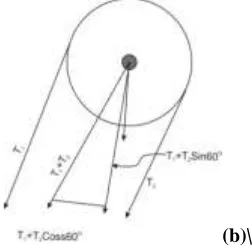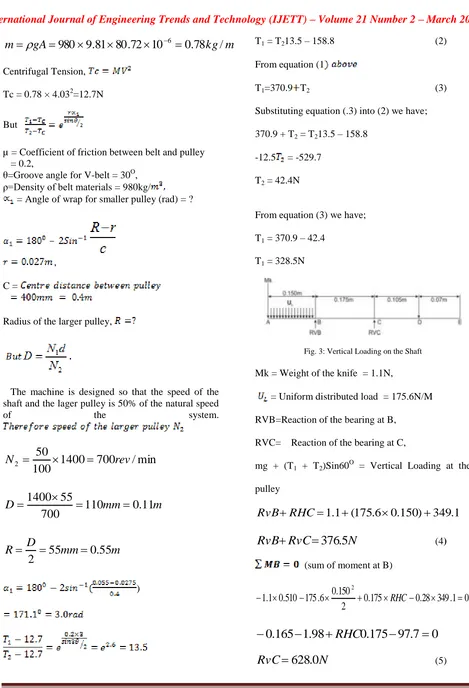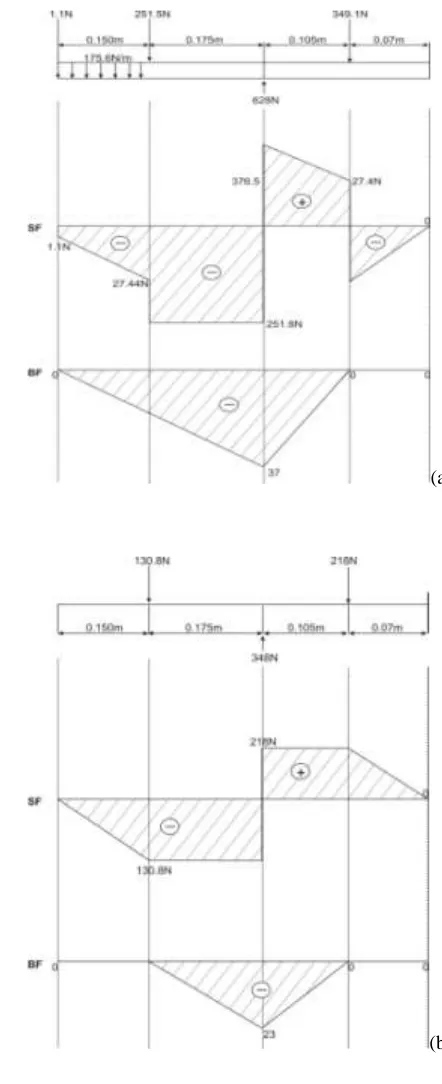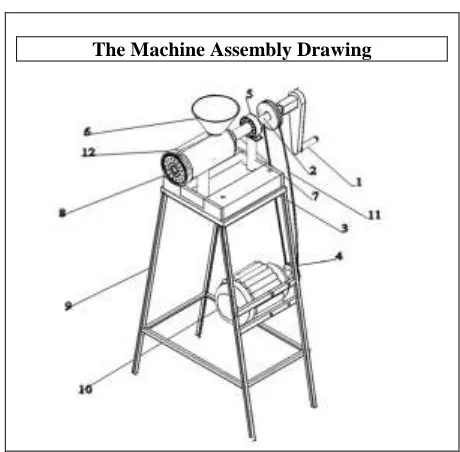ISSN: 2231-5381
http://www.ijettjournal.org
Page 95
Design of a Manual and Motorized Meat
Grinding Machine
Bako Sunday*
1, Mohammed B. Ndaliman#
2 1Department of Mechanical Engineering, Nuhu Bamalli Polytechnic Zaria, Nigeria
2Department of Mechanical Engineering, Federal University of Technology Minna, Nigeria
Abstract- Meat is one of the most essential nutritious food item needed for human consumption from which high quality proteins, minerals and essential vitamins are derived. However, certain categories of consumers such as the children, elderly and sick people might not be able to provide the requisite biting force for tough meat tissues. Thus they would only be able to consume meat in their grinded form. In order to address this problem, it becomes necessary to have a meat grinding machine; in order to ensure good and easy digestion of the meat in their system.
This paper presents the design of an efficient single meat grinding machine with both manual and motorized mode of operation, which can be used at any where (urban and rural area) and at any time (during electric power outage). This design provides the kinematic arrangement of forces, materials selection and proportion of parts to ensure maximum strength and functionality of the machine. To avoid failure of the machine, the working stress (21MN/m2) of the machine is kept within the value of its ultimate stress (30MN/m2).
Keywords- Shaft and Handle Design
I. INTRODUCTION
This paper is the first of its kind ever published. In this design, a single machine with both manual and motorized mode of operation was undertaken. The meat grinding machine is a machine that is used to force meat by means of rotating shaft under pressure through a horizontal mounted cylinder (shaft housing). At the end of the shaft housing there is a cutting system consisting of a cross-shaped knives rotating with the shaft and a stationary perforated disc (hole plate).
The perforation of the hole plate normally range from 1 to 13mm. the meat is compressed by the rotating shaft, pushed through the cutting system and extrudes through the hole in the hole plate after being cut by the revolving knives. The degree of grinding is determine by the size of the holes in the hole plate.
II. DESIGN ANALYSIS AND CALCULATIONS The material selection and proportioning of parts of the meat grinding machine are controlled by their strength, rigidity, corrosion resistance and the
fabrication method. The table I below shows components and their respective materials.
TABLE I. The Machine Components
The Machine Components
(15)
All Dimensions in mm, Scale 1:1
A. To Select the V-belt and Calculate the Torque,
1hp (horse power) = 746W, 2hp = 1402W = 1.402KW
Since the power of the electric motor is 1.402KW; a “A” type of V-belt with a power range of 0,7-3,5 KW, a top width (b) of 13mm and thickness (c) of 8mm (as shown in figure 2) is selected according to Indian Standard (IS: 2494-1974).
Torque transmitted by electric motor, Tt is given by,
P
Tt
,
P = power transmitted by electric motor = Angular speed of the electric motor
N = Speed of rotation of electric motor = 1420rev/min
P
Tt
6
.
146
1492
=10.02NMB. To Calculate the Tightening Belt Tension T1 and
Slackening Belt Tension T2,
(a )
(b)\
Fig. 1: Power Transmission (a) and Analysis of the Pulley (b),
The above diagram shows the loads acting on the
shaft and pulley.
Mg = The weight of the pulley,
(T1– T2)Sin60O = Vertical load on the shaft,
(T1 + T2)Cos60O = Horizontal load on the shaft,
Torque supplied, Tt = (T1 – T2)r,
r = radius of the smaller pulley = 0.02275m
10.2 = (T1 – T2)0.0275
T1 – T2 = 370.9N (1)
Peripheral Velocity, V = ωr
= 4.03m/s
Mass/unit length of belt m = PgA
/ , g = Acceleration due to gravity = 9.8m/ , A = Cross-sectional area of belt
Fig. 2: Cross Section of V-belt
c
b
a
A
(
)
2
1
2 6
10
72
.
80
8
)
13
18
.
7
(
2
1
m
m
kg
gA
m
980
9
.
81
80
.
72
10
6
0
.
78
/
Centrifugal Tension,
Tc = 0.78 × 4.032=12.7N
But
µ = Coefficient of friction between belt and pulley = 0.2,
θ=Groove angle for V-belt = 30O , ρ=Density of belt materials = 980kg/
= Angle of wrap for smaller pulley (rad) = ?
,
C =
Radius of the larger pulley,
The machine is designed so that the speed of the shaft and the lager pulley is 50% of the natural speed
of the system.
min
/
700
1400
100
50
2
rev
N
m
mm
D
110
0
.
11
700
55
1400
m
mm
D
R
55
0
.
55
2
)
T1 = T213.5 – 158.8 (2)
From equation (1
T1=370.9 T2 (3)
Substituting equation (.3) into (2) we have;
370.9 + T2 = T213.5 – 158.8
-12.5 = -529.7
T2 = 42.4N
From equation (3) we have;
T1 = 370.9 – 42.4
T1 = 328.5N
Fig. 3: Vertical Loading on the Shaft
Mk = Weight of the knife = 1.1N,
= Uniform distributed load = 175.6N/M
RVB=Reaction of the bearing at B,
RVC= Reaction of the bearing at C,
mg + (T1 + T2)Sin60O = Vertical Loading at the
pulley
1
.
349
)
150
.
0
6
.
175
(
1
.
1
RHC
RvB
N
RvC
RvB
376
.
5
(4)(sum of moment at B)
0
1
.
349
28
.
0
175
.
0
2
150
.
0
6
.
175
510
.
0
1
.
1
2
RHC
0
7
.
97
175
.
0
98
.
1
165
.
0
RHC
N
RvC
628
.
0
(5)Putting (5) into (4)
N
RvB
376
.
5
628
251
.
5
Moment at A MA = 0
Moment at B MB = (-1.1 × 0.150) – (0.1502 ×175.6) = -2.1N
Moment at C MC = -349.1 × 0.105 = -37.0N-M
Moment at D MD = 0,
Moment at E ME = 0
Fig. 4: Horizontal Loading on the Shaft
(T1 + T2)Cos60 O
= Horizontal loading at the pulley
RHB and RHC = are reaction of the bearing B and C for the horizontal loading
RHB+RHC = 218N (6)
M
B
0
RHC
0
.
175
218
0
.
28
0
0
.
61
175
.
0
RHC
N
RHC
348
.
8
(7)Putting (7) into (6)
RHB + 328.8 = 218N
RHB = 218 – 348.8 = -130.8N
Moment at A MA = 0
Moment at B MB = -218 × 0.28 – 348.8 × 0.175
= 0
Moment at C MC =130 × 0.175=-23.0N-M
Moment at D MD = 0,
Moment at E ME = 0
(a)
(b)
Fig.5: Bending Moment and Shear Force Diagram for Vertical (a) and Horizontal (b) Loading
C. To Calculate the Resultant Maximum Bending Moment, Mmax,
2 2
max
M
HM
VM
MH = Maximum bending moment for horizontal loading = -23NM
Mv=Maximum bending moment for vertical loading = -37NM
2 2
)
37
(
)
23
(
max
M
=43.6NMD. To Calculate the Shaft Diameter d0,
In actual practice shafts are subjected to fluctuating
torque and bending moment. For shafts subjected to
combine bending and torsion, the shaft diameter, do is
given by; 2 2 3
)
.
(
max)
(
16
t t t sO
K
M
K
T
d
The shaft is design to have the maximum allowable
shear stress of
Kb and Kt are Combine shock and fatigue factors for bending and torsion. The recommended value for Kt and Kb are 1.5 and 1.0 for steady loading (Khurmi 2005),
π = 3.142
2 2 6 3
)
2
.
10
1
(
)
6
.
43
5
.
1
(
30
142
.
3
10
16
O
d
d0 = 22.4mm
The diameter of the shaft for the meat grinder is 22mm.
E. Bearing Selection,
The resultant radial force (F) and the dynamic loading (C) are calculated.
2 2
V H
F
F
F
N
RVC
FV
N
RHC
FH
0
.
628
8
.
348
N
F
348
.
8
2
628
.
0
2
718
.
4
Bearing life
Ln
30
,
000
hours
Allowable shaft speed
n
,min
/
700
1400
100
50
rev
n
Constant for ball bearing,
P
3
C = F
p
n
Ln
1 610
60
3 1 610
700
60
000
,
30
4
.
718
=7.759KNThe bearing number 301 having the dynamic loading of 7.65KN is selected
F. To Calculate the Correct Centre Distance C between the Two Pulleys,
The shorter the belt the more often it will be subjected to bending stress while turning around the pulley at a given speed.(Sharma and Aggawal 2006).
The correct centre distance, C is given by:
8 ) ( 8 ) 4 8 ) ( 4 2 2 d D d CD L d D L
C
8 ) 05 . 0 11 . 0 ( 8 ) 055 . 0 11 . 0 ( 142 . 3 4 053 . 1 8 ) 055 . 0 110 . 0 ( 142 . 3 4 053 .
1 2 2
mm
m
C
0
.
4824
482
.
4
G. To Calculate the Factor of Safety, FS,
Ultimate Stress = Maximum Allowable Stress in Shaft = 30 000000N/m2
T = Twisting Moment (Maximum Bending Moment) = 43.6Nm
D = Shaft Diameter = 22mm = 0,022m
According to Sharma and Aggarwal (2006), the Factor of Safety (FS) is between 1.25 to 1.5 for exceptionally reliable material used under controlled condition and subjected to loads and stresses that can be determine certainly. Therefore since the Factor of Safety (FS) of this machine is within the range (1.25 to 1.5); the design is save.
III. KEY DESIGN
In this design, a round key inform of a bolt is selected. With the shaft diameter as a guide, the size of the key, which is the height (h) and the width (b) is determined by using the empirical design code relation for different types of keys.
Fig. 6: Key Analysis and Position on the Shaft
A. To Calculate the Width/Diameter of the Key b,
b = nd
n = Ratio of the key width to the shaft diameter. The
recommended value of n is 0.25
d = shaft diameter = 22mm
b = 0.25 × 22 = 5.5mm
b = 6mm
B. To Calculate the Depth/Height of the Key h,
h = mb
m = Ratio of height of the key to the key width.
The recommended value of m is 1.30
b = 5.5mm
h = 1.3 × 5.5 = 7,15mm
h = 7mm
Therefore, a bolt of 6mm in diameter (width) and the
more than 7mm height is selected.
IV. HANDLE DESIGN
Fig. 7: Handle Analysis
The average of 170.6N effort is assigned to operate the machine during the manual operation.
The maximum force required for a single person to operate the handle is 400N with the handle length of 300mm, (Khurmi. 2005)
Therefore If 400N = 300mm,
mm
N
127
.
95
400
6
.
170
300
6
.
170
A. The Maximum Bending Moment of the Handle ,
B. The Selection Modulus of the Handle Z,
Where, d = diameter of the handle = 11mm =
0.011m and π = 3.142
The diameter of the handle is proportioned as
25mm for single person with the effort of 400N.
Therefore;
400
N
25
mm
m
mm
N
11
0
.
011
32
6
.
170
25
6
.
170
Therefore; 3
3
7
.
130
32
11
142
.
3
mm
Z
C. The Constant Twisting Moment T,
T
p
l
3
2
128
.
0
6
.
170
3
2
T
=14.6N-MD. The Maximum Bending Moment
L
p
M
L
The length of the lever, L is 86mm
E. The Width near the Boss B,
t
B
2
,t = thickness of the lever
The section modulus Z for the level arm is also given by;
2
6
1
B
t
Z
Therefore
4
36
1
7
.
130
t
05
.
196
3
t
mm
t
6
.t
B
2
2
6
12
mm
F. The Dimension or Length of the Square End, of the Handle x,
2
2 D
x , D = Shaft diameter = 22mm
mm
x
15
.
5
2
22
2
x = 16mm
V. MACHINE ASSEMBLY
Table II, shows the position of the various machine components and their respective materials.
TABLE II. The Machine Assembly
All dimensions in mm, Scale 1:1
S/N Component Material Qty
1 Handle MS, P 1
2 Shaft & Key SS,MS 1
3 Grinder Base MS 1
4 Motor Pulley MS 1
5 Bearing SS 2
6 Hopper SS 1
7 Bearing Housing MS 2
8 Hole Plate A 3
9 Stand Ms 1
10 Electric Motor MS, R !
11 V-belt R, C, R 1
12 Ring Screw A 1
13 Shaft Housing SS 1
14 Knife SS 1
15 Bolt & Nut M12x1,25 M16x1,5
MS MS
6 4
16 Grinder Leg MS 1
A-Aluminum, C-Cord, F-Fabric, MS-Mild Steel SS-Stainless Steel, R-Rubber
VI. CONCLUSIONS
To avoid failure of the machine, the working stress is kept within the ultimate stress of the machine. From the Shear Force (SF), Bending Moment (BM) diagram and the value of the Factor of Safety (FS), we conclude that the design is save. We hereby recommend this machine for construction and call on food Engineers and Technologist to develop different types of meat products that can be produced from grinded meat. We also call on entrepreneurs to develop new business model that will utilize the use of this machine for entrepreneurship in order to create jobs and to the reduce the rate of unemployment in the societies,
Finally, if this machine is utilized for the production of grinded meat products: Hospitals, Nurseries and Primaries schools would be a good market for selling of these products.
REFERENCES
[1]. L. Robert Mott. Machine Element in Mechanical
Design. Fourtt Edition. Upper Saddle River, New Jessey. Pp 548-551. 2004.
[2]. M B. Adeyemi Mechanical Engineering Design, MEE
513 Federal University of Technology Minna.Nigeria, 2008.
[3]. O. Robert and Parmley P.E. Illustrate Source of
Mechanical Components.McGraw Hill Company Inc. Pp 4-5. 2000.
[4]. P.C. Sharma and Aggarwal D.K. Machine Design.
Eleventh edition. S.K. Kataria & Son. Pp 390, 492, 641-644. 2006.
[5]. Principles of Meat Processing Technology. Available
at; www.foa.org/dcrep/010/ai407e/ai407e04.htm. cited in December 2014..
[6]. Khurmi R.S. Machines design. Eurasia Publishing
House. Ram Nagar, New Delhi. Pp 4-5, 52-57, 568-571, 716-719, 728-729,1012-1015. 2005.
[7]. Khurmi R.S. Theory of machines. Eurasia Publishing




